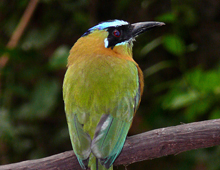Description: The head of the Blue-crowned motmot is large; the short broad beak has an upper edge that is serrated. They only have one rear toe and the middle and inner toes on their short feet are fused; legs and feet are gray in color. The center tail feathers, which twitch like the pendulum of a clock when the motmot is perched, have bare spines at the tip, making them easy to recognize. Their plumage is shades of green and blue. They have red eyes, a turquoise crown and black masked face. Male and female plumage is alike but males are larger in size.
Size: The Blue-crowned motmot is 15-19 inches (38-48 cm.) long and weighs about six ounces (170 gr).
Behavior: These birds are not very social, not congregating in large flocks. They usually live throughout the year in pairs. During the day, members of a pair will forage separately. Unlike most birds, they are very active in the twilight and into the night. Although they build burrows under ground, they sleep above ground among the foliage. Males have been observed carrying inedible objects in order to court a mate, or on occasion, to win a mate by breaking up an existing pair. They are fast fliers, flying for short distances, darting from tree to tree.
Diet: Blue-crowned motmots feed primarily on insects, crushing them with their serrated bill. They also include fruit and larger prey animals like lizards, frogs and even mice in their diet. If unable to swallow the prey whole, they hit it against a
branch to kill it.
Senses: Eyesight and hearing are used for mating and foraging.
Communication: Their call is described as somewhat similar to that of an owl, a double hoot, although it is believed that their strange common name comes from their whooping calls. The swinging of their tails like a clock pendulum may signal to potential predators that they are aware of their presence.
Reproduction: Blue-crowned motmots burrow underground for nesting. Burrowing begins during the rainy season when digging is easier and it gives the burrow time to age and not look new and more easily targeted by predators. Three to five eggs are usually laid between March and June and are incubated by both sexes for approximately two to three weeks. Parents tend to the blind and completely naked hatchlings for three or four days, then leave them unattended at night but feed them during the day until they are ready to leave the burrow about a month later.
Habitat/range: Blue-crowned motmots inhabit open woodlands and edges of tropical rainforests from Mexico to Argentina.
Status: They are listed as Least Concern on IUCN Red List.



